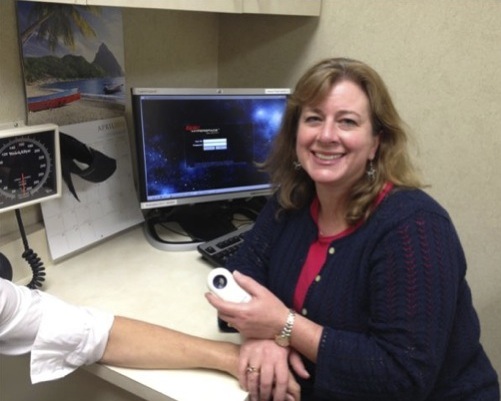Mole removal
Mole removal
Many people refer to a mole as any dark spot or irregularity in the skin. Some people are born with moles while other moles appear over time. The most common types of moles are skin tags, raised moles and flat moles. A family history of moles known as dysplastic (atypical), can be associated with a higher frequency of skin cancer so diligence in monitoring mole changes on yourself is critical.
Moles can be removed surgically by excision (cutting) or cauterization (a tool used to burn away the mole) depending on the depth of the mole and the desired cosmetic outcome.
To learn more, visit the American Academy of Dermatology.

Teresa Wrobbel, MD, evaluates moles on a patient’s forearm at the Stellis Health-Medical Skin Care Center
Mole Removal
You Can Get Rid of Unwanted Moles
Moles are natural skin lesions and appear on most people’s bodies. Many people refer to a mole as any dark spot or irregularity in the skin. Some people are born with moles while for others, moles appear over time. Most moles appear on a person’s body before the age of 20; however, as we age moles may appear later in life as well.
The most common types of moles are skin tags, raised moles and flat moles. A family history of moles known as dysplastic (atypical) can be associated with a higher frequency of skin cancer so diligence in monitoring mole changes on yourself is critical.
Moles can be removed surgically by excision (cutting) or cauterization (a tool used to burn away the mole) depending on the depth of the mole and the desired cosmetic outcome. Other methods of removal are cryotherapy (freezing the mole) and laser therapy.
Moles are typically nothing to worry about, but they can develop into skin cancer.
When Should You Talk to Your Provider About a Mole?
It’s important to get a new or existing mole checked out if there are any of the following symptoms:
• New growth
• Changes in shape
• Looks uneven
• Changes in color
• Gets darker
• Has more than two colors
• Starts to itch, crust, flake or bleed
Most moles are benign, but some can be very dangerous. Mole treatment is necessary to determine the difference between a harmless growth and something more suspicious. Many people choose to have a mole removed for cosmetic reasons, but make sure to make an appointment with your provider if you see any changes in a mole you’ve had for a while.
What Types of Skin Moles Do You Have?
Benign (Normal) Nevi
These are normal,
small pinkish/brownish
moles
Conteginal Nevi
Moles that are present
at birth and have a
chance of developing
skin cancer
Dysplastic Nevi
Larger and irregular
moles
Is removing a mole a good idea?
Most moles are harmless and do not need to be removed. Your provider can determine if the mole is harmful at an appointment. If a mole rubs against clothing and is irritating, you may want it removed. People also get moles removed for cosmetic reasons. If a mole changes in size, shape, or color, it is important to have it looked at because it may be precancerous or cancerous. A biopsy may be taken at your appointment and the results will indicate if the mole is cancerous.
Can moles be completely removed?
- excision where the mole is cut out
- cautery which burns off the mole
- cryosurgery which freezes the mole and it falls off
- laser where bursts of light radiation destroy the mole tissue


